Abstract
The in vitro regulation of fetal hemoglobin (HbF was investigated in clones of cultured adult human erythroid cells by in situ immunofluorescent identification of the hemoglobins synthesized. Formation of Hb F-containing clones was enhanced by erythropoietin and by culture conditions favoring the proliferation of less-differentiated stem cells of the burst-forming-unit type. Burst-forming units differed in their capacity to direct Hb F synthesis in their terminally differentiated progeny. A class of early precursors that can produce descendent stem cells with or without commitment to Hb F production was identified. The findings suggest that the capability for expression of Hb F in terminally differentiated cells of the adult is determined at the level of less-differentiated erythroid stem cells with characteristics of burst-forming units. It is proposed that the regulation of Hb F synthesis in vivo is also linked to the process of differentiation of the erythroid stem cells and that the patterns of Hb F synthesis during ontogeny reflect the attainment of progressively higher levels of differentiation of erythroid stem cells as development proceeds.
Full text
PDF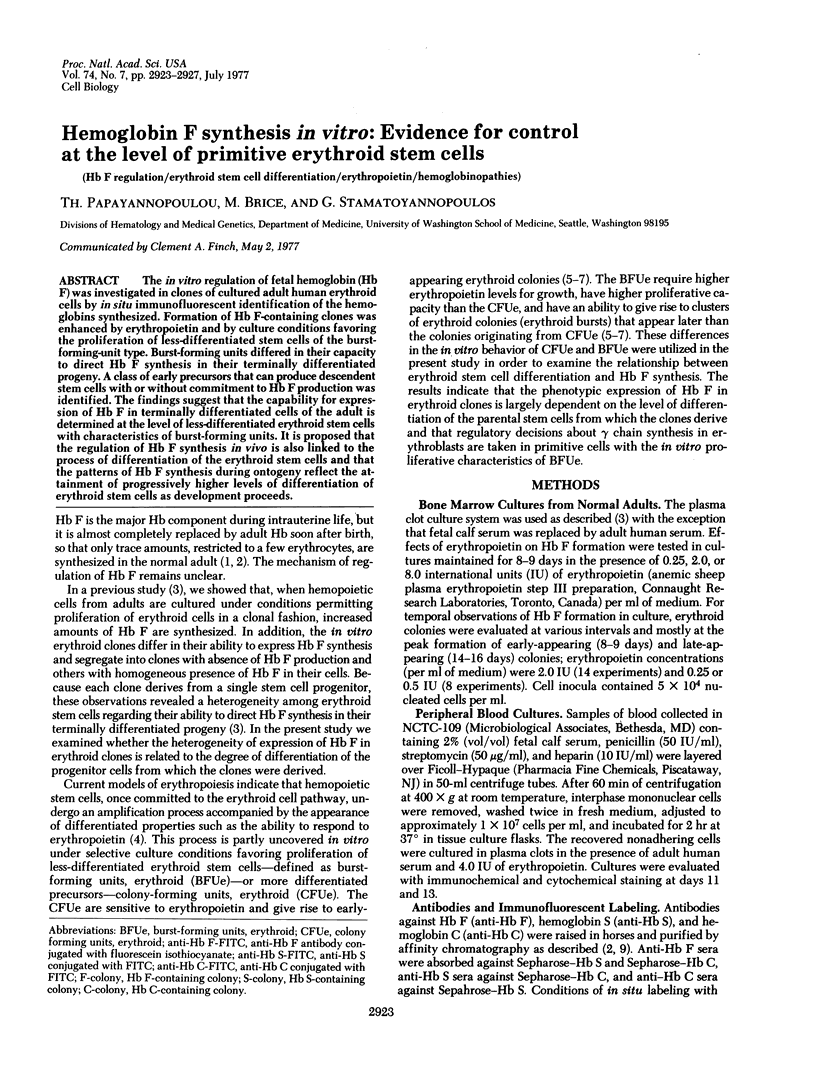
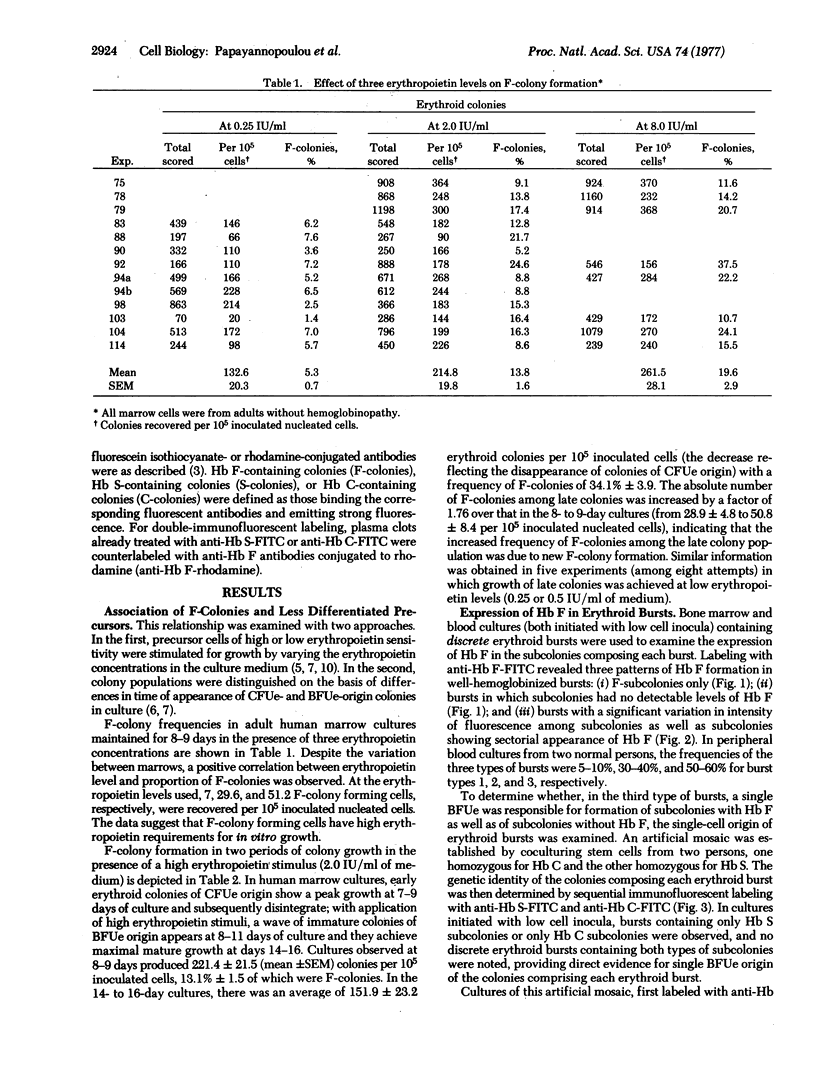
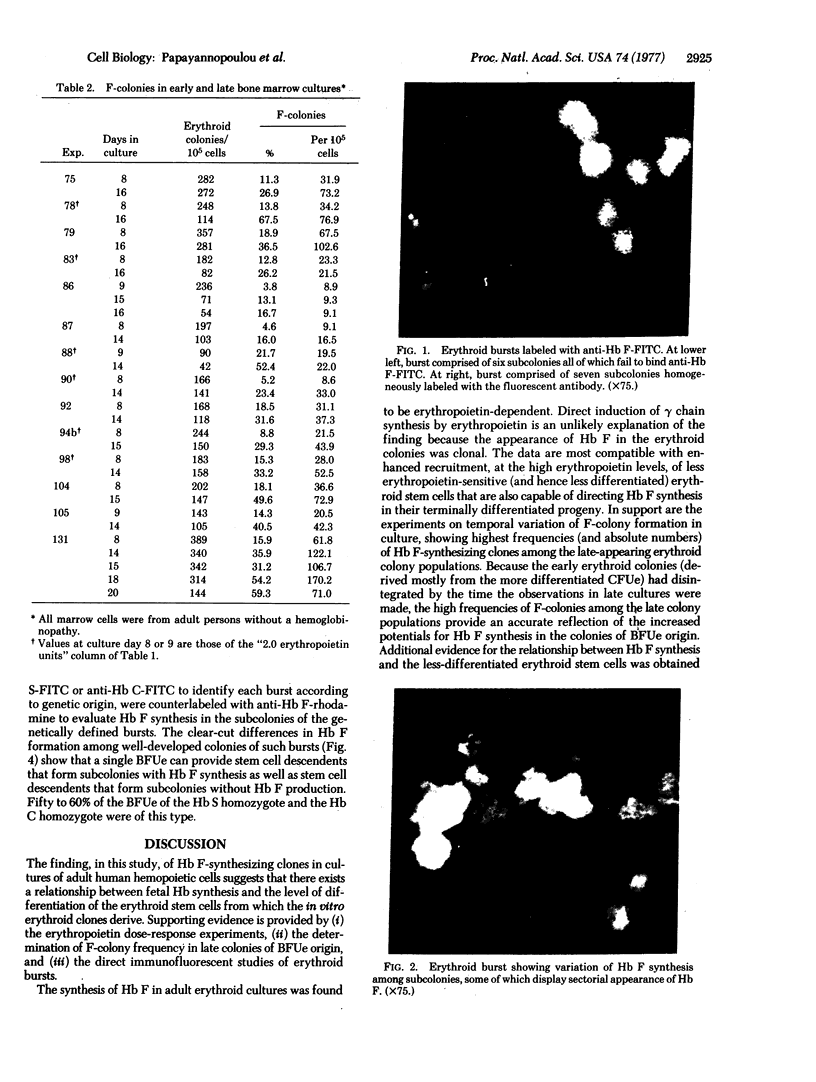
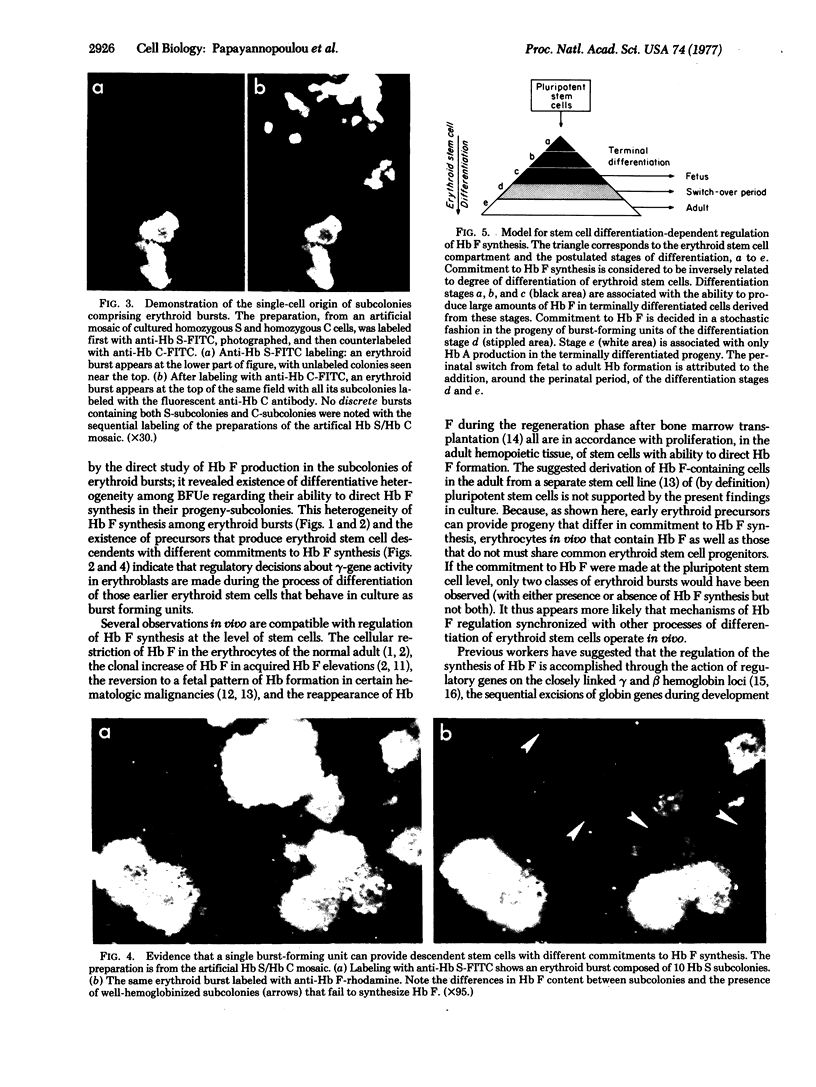
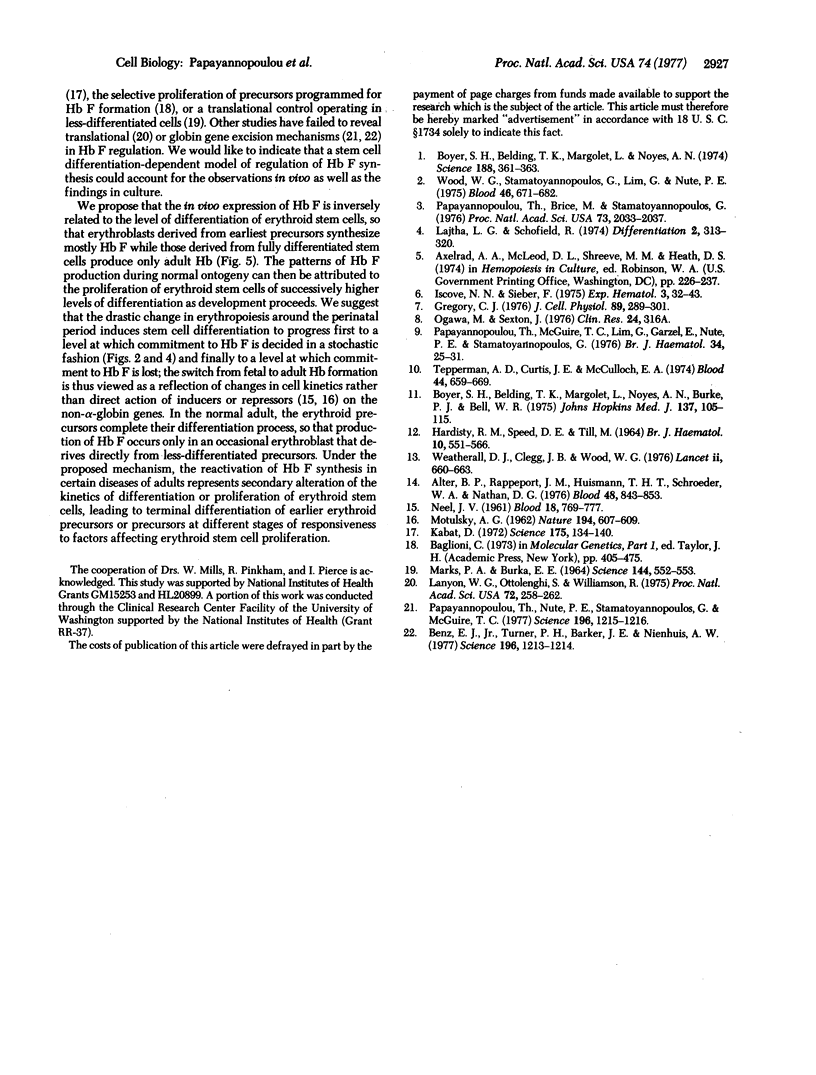
Images in this article
Selected References
These references are in PubMed. This may not be the complete list of references from this article.
- Alter B. P., Rappeport J. M., Huisman T. H., Schroeder W. A., Nathan D. G. Fetal erythropoiesis following bone marrow transplantation. Blood. 1976 Dec;48(6):843–853. [PubMed] [Google Scholar]
- Benz E., Jr, Turner P., Barker J., Nienhuis A. Stability of the individual globin genes during erythroid differentiation. Science. 1977 Jun 10;196(4295):1213–1214. doi: 10.1126/science.860136. [DOI] [PubMed] [Google Scholar]
- Boyer S. H., Belding T. K., Margolet L., Noyes A. N. Fetal hemoglobin restriction to a few erythrocytes (F cells) in normal human adults. Science. 1975 Apr 25;188(4186):361–363. doi: 10.1126/science.804182. [DOI] [PubMed] [Google Scholar]
- Boyer S. H., Belding T. K., Margolte L., Noyes A. N., Burke P. J., Bell W. R. Variations in the frequency of fetal hemoglobin-bearing erythrocytes (F-cells) in well adults, pregnant women, and adult leukemics. Johns Hopkins Med J. 1975 Sep;137(3):105–115. [PubMed] [Google Scholar]
- Gregory C. J. Erythropoietin sensitivity as a differentiation marker in the hemopoietic system: studies of three erythropoietic colony responses in culture. J Cell Physiol. 1976 Oct;89(2):289–301. doi: 10.1002/jcp.1040890212. [DOI] [PubMed] [Google Scholar]
- HARDISTY R. M., SPEED D. E., TILL M. GRANULOCYTIC LEUKAEMIA IN CHILDHOOD. Br J Haematol. 1964 Oct;10:551–566. doi: 10.1111/j.1365-2141.1964.tb00732.x. [DOI] [PubMed] [Google Scholar]
- Iscove N. N., Sieber F. Erythroid progenitors in mouse bone marrow detected by macroscopic colony formation in culture. Exp Hematol. 1975 Jan;3(1):32–43. [PubMed] [Google Scholar]
- Kabat D. Gene selection in hemoglobin and in antibody-synthesizing cells. Science. 1972 Jan 14;175(4018):134–140. doi: 10.1126/science.175.4018.134. [DOI] [PubMed] [Google Scholar]
- Laijtha L. G., Schofield R. On the problem of differentiation in haemopoiesis. Differentiation. 1974 Oct;2(5):313–320. doi: 10.1111/j.1432-0436.1974.tb00366.x. [DOI] [PubMed] [Google Scholar]
- Lanyon W. G., Ottolenghi S., Williamson R. Human globin gene expression and linkage in bone marrow and fetal liver. Proc Natl Acad Sci U S A. 1975 Jan;72(1):258–262. doi: 10.1073/pnas.72.1.258. [DOI] [PMC free article] [PubMed] [Google Scholar]
- MARKS P. A., BURKA E. R. HEMOGLOBINS A AND F: FORMATION IN THALASSEMIA AND OTHER HEMOLYTIC ANEMIAS. Science. 1964 May 1;144(3618):552–553. doi: 10.1126/science.144.3618.552. [DOI] [PubMed] [Google Scholar]
- MOTULSKY A. G. Controller genes in synthesis of human haemoglobin. Nature. 1962 May 12;194:607–609. doi: 10.1038/194607b0. [DOI] [PubMed] [Google Scholar]
- NEEL J. V. The hemoglobin genes: a remarkable example of the clustering of related genetic functions on a single mammalian chromosome. Blood. 1961 Dec;18:769–777. [PubMed] [Google Scholar]
- Papayannopoulou T. H., Brice M., Stamatoyannopoulos G. Stimulation of fetal hemoglobin synthesis in bone marrow cultures from adult individuals. Proc Natl Acad Sci U S A. 1976 Jun;73(6):2033–2037. doi: 10.1073/pnas.73.6.2033. [DOI] [PMC free article] [PubMed] [Google Scholar]
- Papayannopoulou T. H., Mcguire T. C., Lim G., Garzel E., Nute P. E., Stamatoyannopoulos G. Identification of Haemoglobin S in red cells and normoblasts, using fluorescent anti-Hb S antibodies. Br J Haematol. 1976 Sep;34(1):25–31. doi: 10.1111/j.1365-2141.1976.tb00170.x. [DOI] [PubMed] [Google Scholar]
- Papayannopoulou T. h., Nute P. E., Stamatoyannopoulos G., McGuire T. C. Hemoglobin ontogenesis: test of the gene excision hypothesis. Science. 1977 Jun 10;196(4295):1215–1216. doi: 10.1126/science.323976. [DOI] [PubMed] [Google Scholar]
- Tepperman A. D., Curtis J. E., McCulloch E. A. Erythropietic colonies in cultures of human marrow. Blood. 1974 Nov;44(5):659–669. [PubMed] [Google Scholar]
- Weatherall D. J., Clegg J. B., Wood W. G. A model for the persistence or reactivation of fetal haemoglobin production. Lancet. 1976 Sep 25;2(7987):660–663. doi: 10.1016/s0140-6736(76)92469-7. [DOI] [PMC free article] [PubMed] [Google Scholar]
- Wood W. G., Stamatoyannopoulos G., Lim G., Nute P. E. F-cells in the adult: normal values and levels in individuals with hereditary and acquired elevations of Hb F. Blood. 1975 Nov;46(5):671–682. [PubMed] [Google Scholar]






